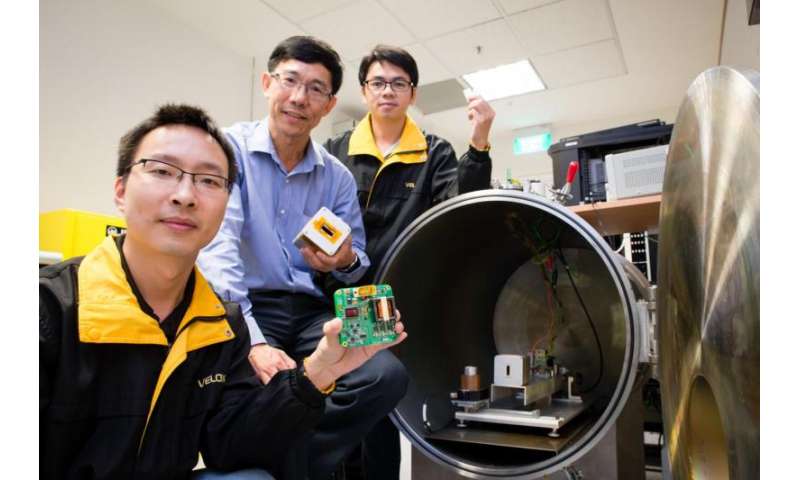NTU Singapore partners with Japanese university to launch new satellite

Singapore's newest satellite will be the result of a new Singapore-Japan partnership.
Nanyang Technological University (NTU Singapore) is partnering with Kyushu Institute of Technology (Kyutech), which has one of Japan's most established university space engineering programmes, to build and launch a new satellite.
Named AOBA VELOX-III, the new nanosatellite weighing two kilogrammes will be launched by Japan's national agency, the Japan Aerospace Exploration Agency (JAXA) in 2016.
The satellite will be launched to the International Space Station, the 110 metre habitable human-made satellite that orbits Earth, for a subsequent injection into its orbit 400 kilometres above sea level.
This joint satellite development programme, the first such partnership between universities from both countries, was announced today (13 Jul) at a press conference held at Kyutech in Japan. The latest satellite marks another important milestone for NTU as this is the first time its satellite programme is using a micro-propulsion system.
The made-in-NTU micro-propulsion system will be mated with the main system bus of the satellite, which will be built by Kyutech's Laboratory of Spacecraft Environment Interaction Engineering.
The AOBA VELOX-III has three missions - to test the micro-propulsion system developed by NTU, to test a new wireless communication system developed by Kyutech and to evaluate the durability of commercial off-the-shelf microprocessors in space.
Associate Professor Low Kay Soon, Director of NTU's Satellite Research Centre said the VELOX-III will be testing the newly developed micro-propulsion system that can generate small thrusts used for fine altitude control and drag compensation.
"This new micro-propulsion system will be a game-changer for small satellite systems. Such small satellite projects usually have a modest budget and insufficient space to mount the conventional thrusters used by bigger satellites to maintain altitude," Prof Low said.
"After four years of development work, we are now ready to test our thruster technology at the final frontier of space and to make a historical partnership with our Japanese collaborators at Kyutech."
Professor Mengu Cho, Director of Kyutech's Laboratory of Spacecraft Environment Interaction Engineering, said: "One of the main reasons why we are partnering NTU is because of their satellite expertise and professionalism, demonstrated by NTU's successful satellite missions and a world-class satellite research facility. Prof Low and I have known each other for years and we already had several staff and student exchanges."
"The AOBA VELOX-III marks a successful execution of the collaboration, which was formalised by a Memorandum of Understanding signed last year between our institutions. This joint programme also enhances the interaction of the undergraduate and postgraduate students pursuing satellite research in both countries."
New satellite systems developed
NTU's new micro-propulsion system generates a small amount of thrust using pulsed plasma - commonly known as a plasma propulsion engine.
The plasma, which generates a very small thrust that could lift the satellite about 90 metres for each hour of flight, is produced by using 1500 volts of electricity applied to Teflon, a common fuel material for satellites.
It will be used to maintain the satellite speed of 27,000km/h, which usually drops over time, due to the drag caused by the surrounding atmosphere at low earth orbit.
The NTU engineers estimates that there is enough fuel for the thruster to keep the satellite in space for up to six months, about twice as long as the usual three months flight time for nanosatellites.
The wireless communication system carried by AOBA VELOX-III will be using affordable Wi-Fi technology commonly used in mobile devices and routers found in homes and offices.
Developed by Kyutech, it will be demonstrated in space for the first time. If proven successful, future satellite missions could adopt this wireless technology for intra-satellite communication - different subsystems of a satellite communicating with each other.
NTU's satellite programme
NTU is the first university in Singapore to launch a satellite programme for undergraduates and postgraduates.
Since 2009, top engineering students have participated in the development of real satellites under this programme.
The AOBA VELOX-III satellite will be NTU's seventh satellite in space and its third nano-satellite.
Previously, NTU has successfully launched X-SAT, a 105kg microsatellite; VELOX-I, a 4.3kg nano-satellite; and two pico-satellites named VELOX-PII and VELOX-PIII.
In addition, a 12kg nano-satellite named VELOX-II in collaboration with Addvalue Innovation Pte Ltd is at its final stage of development, scheduled to be launched by the end of 2015.
A 135kg microsatellite named VELOX-CI for climate research funded by the Economic Development Board is also in the pipeline.
Provided by Nanyang Technological University